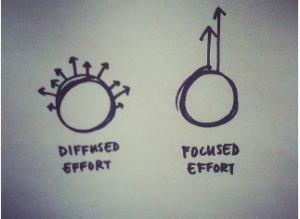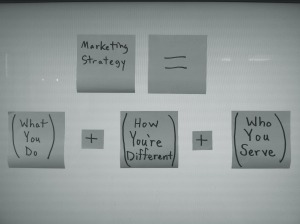The goal of marketing strategy is to figure out smart ways to compete with your product or service. The problem I find with the strategies of many small to medium-sized businesses (SMBs) is simply not enough business focus. Companies are pulled in countless directions by market forces and customer demands. Especially if the business has been around for a while. In an effort to grow sales, many companies have expanded their product or service scope, have widened the net of their target audience, and have lost sight of how they are unique and what they stand for. They have morphed until they are indistinguishable from most of their competitors. Many customers are left without a highly compelling reason to buy from these companies any longer.
Surprisingly, the key to regaining business growth often requires more focus. I call this the paradox of focus because it is counterintuitive to human nature and market forces. The natural tendency is to add-on, to do more, to say ‘yes’. As a company loses its unique competitive position, the top line may grow but the bottom line remains flat or declines because of downward pressure on sales price.
There are very few companies that consistently generate superior financial performance over long periods of time. Successful companies work very hard to maintain a unique market position. Great profit margins exist in the rare space of unique competitive position.
It doesn’t mean that a company’s strategy shouldn’t change over time. It simply means that you shouldn’t unconsciously let your scope creep to the point that you lose what makes your business special. Evolution is healthy as long as it is thoughtful. Furthermore, it doesn’t mean you shouldn’t experiment or be opportunistic at times. What we’re talking about is your core business. At its most basic level, specialization is the essence of good marketing strategy for most SMBs. To help you evaluate or re-evaluate your marketing strategy, think about these three topics as they relate to your current position:
2.How You’re Different
3.Who You Serve
Like many business concepts, marketing strategy really isn’t difficult to understand. However, as is often the case in life, the hard part is in implementation. Marketing strategy can be surprisingly hard to get right in a dynamic industry with multiple competitors. Let’s take a look at these three in more detail.
1) What You Do
‘What You Do’ is an exercise in being very explicit about what work you will do. If you’re a services company, it’s about the specific services you will provide. If you’re a product company, it’s what products you will produce or what industry you will serve. If you’re a custom job shop, it defines the types of projects you will work on or the materials you will work with. The flip side to this exercise is also defining what you won’t do. According to Michael Porter, a leading scholar on strategy at Harvard Business School, “Strategy is most importantly about defining what you won’t do.”
In order for a business to be very good at something – and recognized by customers for this competence – you have to focus on a few carefully selected things at the exclusion of many others. It’s not that you can’t do the other things, or couldn’t if you worked at it, it’s simply that by trying to be all things to all customers you end up being not very memorable about anything. One of my favorite sayings is “You can do anything, but you can’t do everything.” Or, you shouldn’t try. So, be very clear about ‘what you do’ and work very hard at fighting off scope creep.
2) How You Are Different
‘How You Are Different’ is about doing things differently than other providers. The key here is to be different in measurable ways that are both easily recognizable and valuable to your target audience. You can be different in any aspect of your customer value chain, including:
• product design
• product quality
• services offered
• target audience
• process technology
• reliability/dependability
• people/talent/staff
• values/culture/brand
• price/guarantee
• customer service
• advertising/promotion/PR
• distribution channels and partners
 A common pitfall for companies in defining how it is different is to simply say, “We Will Be The Best”. Trying to ‘be the best’ by offering essentially the same exact product or service to your customers is a race to the bottom.
A common pitfall for companies in defining how it is different is to simply say, “We Will Be The Best”. Trying to ‘be the best’ by offering essentially the same exact product or service to your customers is a race to the bottom.
Being unique is better than being ‘the best’ because there is no one universal industry ‘best’. ‘Best’ means different things to different customers. In an effort to understand this point, let’s take a closer look at the U.S. airline industry.
For most of the past 30 years, no customer can really tell the difference between Delta, United, American, and the other major airlines. Unless you’re someone with great knowledge of the industry, you simply can’t tell them apart. They may as well all have the same name and logo. The big airline companies have been fighting tooth and nail to ‘be the best’ for decades and have been completely undifferentiated in every meaningful way.
Meanwhile, Southwest Airlines had a very different approach. They chose a distinct marketing strategy by not competing directly with the major airlines. Southwest’s short-haul, budget-priced approach didn’t work for every customer, but many customers loved what they did. Southwest did what they did very well and were easily recognized for being the best at that one thing. Southwest was the only airline company in the U.S. that was consistently profitable from 1980s to the present.
Steve Jobs of Apple may have said it best, “We can’t look at the competition and say we’re gonna do it better. We have to look at the competition and say we’re gonna do it differently.”
3) Who You Serve
In deciding who you will serve with your product or service, the key is to know which customers value your uniqueness. ‘How You’re Different’ and ‘Who You Serve’ go hand in hand. In deciding how you are different, you must in parallel decide ‘for whom’. The natural tendency is to increase the scope of your target audience, not narrow it. It’s hard to tell a customer ‘no’. It’s hard to walk away from ‘closing a deal’. Winning new business is exciting. Yet, saying no or walking away is exactly the right decision in some situations if you want to grow profitably.
 Become very close to a specific subset of customers that appreciate your uniqueness. Your target audience can be differentiated in many ways including a) geography, b) size, c) industry, or a number of other demographics. Understand your customers’ problems, their needs, and their hot buttons. And be the very best at serving these specific customers better than any other provider.
Become very close to a specific subset of customers that appreciate your uniqueness. Your target audience can be differentiated in many ways including a) geography, b) size, c) industry, or a number of other demographics. Understand your customers’ problems, their needs, and their hot buttons. And be the very best at serving these specific customers better than any other provider.
Conclusion
Many businesses lose focus over time. What makes a new business compelling in the early stages can fade as it grows and matures. The scope of what it does and who it serves can creep until the point where margins begin to erode and someone says, ‘something must be done.’
Here are a few tips to help get things started in thinking about your marketing strategy. Ask yourself these questions. These questions can lead to interesting discussions about what you do best, how you’re different, and who your best customers are:
1. What project or product from the past 24 months are we proudest of?
2. Which of our current clients would freak out if we disappeared tomorrow?
3. Which work seems the most effortless for us?
4. Which work do we rarely get push-back on price?
5. What project or product do we make the best margin on?
6. Which products or services would our core customers not miss if we stopped tomorrow?
7. Which areas do we not have any head-to-head competition?
8. Who are our main competitors and how are we different?
More products, more services, a bigger target audience. Better, right? When it comes to marketing strategy, bigger is not always better. Until your revenue approaches that of Google, or Proctor&Gamble, or Wal-Mart, ‘going big’ is typically not the smartest, most profitable path to growth. It’s the ultimate paradox in business. It’s the paradox of focus.


Leave A Comment